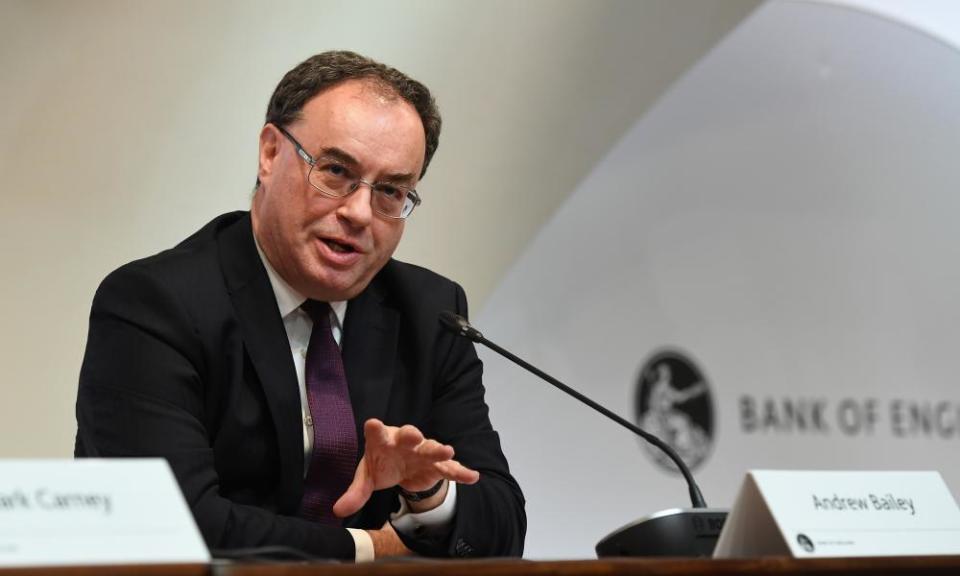Britain isn’t ‘recovering’, whatever the Bank may suggest

The UK is performing better than expected. That was the message from the Bank of England’s governor, Andrew Bailey, following its latest review of the economy.
It was a message he almost muttered under his breath, as if knowing that almost anyone listening would yell back: “Oh no it isn’t!”
There is more tumbleweed blowing through city centre shopping districts than there are people queuing at the tills. And about 7 million people remain on furlough and in fear of losing their job when the £30bn job retention scheme subsidies come to an end in October.
To infer from this that the economy is bubbling back to life would be highly misleading. When the public know of so many businesses and households struggling to cope, statements that seem to suggest the country is recovering from a record-breaking decline in GDP are like a bad joke.
Officials at the Bank did not so much say the economy was bouncing back as embarrassedly admit that their own forecast back in May had been a little too gloomy about the short-term impact of coronavirus. In their poorly judged assessment three months ago, they sketched out a V-shaped recovery that also included an overly optimistic view of how the economy would recover next year. They admitted they were wrong about that, too.
The number of people visiting high streets and shopping centres, which dropped by 80% in the first weeks of the lockdown, was still down by a third last week
Following the recalibration of its analysis, the Bank now expects what most other forecasters have predicted. In summary, the economy is still heading for one of the worst downturns in the developed world and will take years to claw itself back to anything like the level of activity seen last year.
This outlook is emphasised by the most recent data. The number of people visiting high streets and shopping centres, which dropped by 80% compared with the 2019 average in the first weeks of lockdown, was still down by a third last week.
The UK car industry is only crawling back from a disastrous first six months that saw it produce the lowest number of vehicles since 1954.
So far, automotive firms have reported only about 11,000 job losses after much of the industry furloughed staff. The next few months are expected to be much uglier for job cuts.
Some analysts believe that one in six of the 168,000 workers directly employed in vehicle manufacturing could lose their jobs by next year, and many more from the 823,000 employed across the whole sector as the UK’s largely foreign-owned car industry retrenches to home soil. Brexit will play a part in this too.
More broadly, as many as a third of UK employers expect to cut jobs when the furlough scheme ends in October. A survey by the Chartered Institute of Personnel and Development (CIPD) and recruitment firm Adecco found that 33% of the more than 2,000 companies, charities and public sector bodies surveyed expected to make redundancies in the third quarter.
What does the Bank have to say about the gloomier outlook? Dave Ramsden, a member of the nine-strong monetary policy committee (MPC) that Bailey chairs, said last week he would be prepared to vote for an extra stimulus package. This would be in addition to the £100bn the committee agreed in June, which took the overall level of quantitative easing (QE) to £745bn.
Ramsden is the first Bank employee to say he is amenable to further action. Until now, that impetus has come from the external members of the MPC – the former City economist Michael Saunders and the academics Silvana Tenreyro and Jonathan Haskel. Bailey, his deputies Ben Broadbent and Jon Cunliffe, and chief economist Andy Haldane, have proved much more reticent. The fourth external MPC member, Gertjan Vlieghe, another former City economist, has been largely silent on the subject.
So far, the central bank’s actions have mirrored the government’s need for extra borrowing. The Treasury has said it will borrow an extra £300bn this year, and, lo and behold, that is the total of extra lending from the Bank of England.
This tactic means private-sector banks cannot lend to the government but must lend elsewhere: hopefully to good businesses temporarily damaged by recent events. To some extent, that is the point of QE. However, as if we had learned nothing from previous recoveries, high street banks will spurn requests from businesses for long-term loans, instead competing more intensely for mortgage customers, thereby boosting house prices.
It’s not the banks’ fault; it is in their DNA to lend to the safest and most profitable customers. They need guidance. If the Bank cannot provide a reliable guide to the economy, it can at least steer its QE funds in the right direction.

